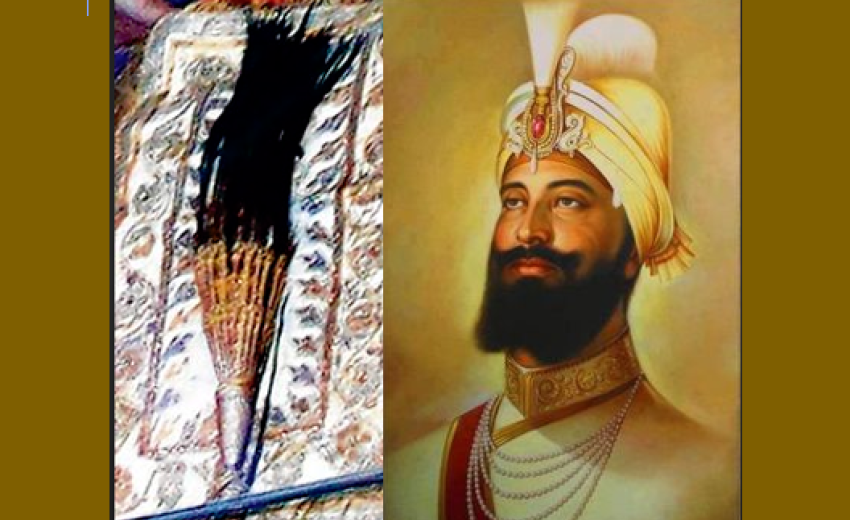(Top) The plume believed to have been worn by Guru Gobind Singh; a sketch that shows him with a kalgi
 Aug. 16: A
plume believed to have been worn by the tenth Sikh guru, Guru Gobind
Singh, has been brought to Punjab from Britain but a section of Sikh
clerics is waiting for evidence that it is genuine.
Aug. 16: A
plume believed to have been worn by the tenth Sikh guru, Guru Gobind
Singh, has been brought to Punjab from Britain but a section of Sikh
clerics is waiting for evidence that it is genuine.
 The
Shiromani Gurdwara Prabandhak Committee (SGPC), which is responsible
for the upkeep of gurdwaras and decides on religious matters, is
reluctant to give its sanction of authenticity to the revered artifact.
The
Shiromani Gurdwara Prabandhak Committee (SGPC), which is responsible
for the upkeep of gurdwaras and decides on religious matters, is
reluctant to give its sanction of authenticity to the revered artifact.
The Akal Takht, the highest institution of Sikh polity, has, however, accepted the authenticity of the kalgi or plume. After it was brought to Amritsar on July 3, it had been displayed in the Takht within the Harmandir Sahib complex before questions over its authenticity were raised. The plume has now been kept in the toshakhana (strongroom) of the Golden Temple.
SGPC chief Avtar Singh Makkar has appointed a fact-finding panel but it has failed to arrive at a conclusion because no detailed physical description of the plume is available
“We cannot come to any hasty conclusion. We are looking at all aspects, studying it from all historical perspectives,” said Dalmegh Singh, SGPC secretary and co-ordinator of the fact-finding committee.
The panel has suggested carbon dating but Sikh scholars have rejected it. They argue that while the test may establish the plume’s age, it cannot link it to Guru Gobind Singh (1666-1708), who was known as kalgidhar (one who wears the plume).
But Akal Takht jathedar (head) Giani Gurbachan Singh has endorsed the plume’s authenticity. He was present at Amritsar airport when the plume was brought on a special flight from Delhi.
Punjab chief minister Parkash Singh Badal, considered close to the SGPC, has maintained a studied silence though a two-member “research team” that brought the kalgi from London had kept him informed about it.
IPS officer Harpreet Singh Sidhu, who was doing an MPhil in criminology at Cambridge University, and Kamaljit Singh Boparai, a businessman, had teamed up to get possession of the plume. They have declined to state how they got the relic.
It is believed that the plume was handed over to them by a UK-based Sandhu family. Its scion, Atam Singh Sandhu, has come forward to state that at no point had he claimed that the plume belonged to Guru Gobind Singh. Sandhu is the son of Chanan Singh Chan, a well-known UK-based collector of Sikh heritage artefacts.
It is not known, however, how the Sandhus came to possess the plume.
According to Sidhu, a Punjab-cadre officer, the plume was believed to have been in the possession of Sikh emperor Maharaja Ranjit Singh, who ruled from 1801 to 1839 and had his capital in Lahore.
“Court records of the Lahore durbar and the daily diary of Faqir Azzizuddin (a minister of Ranjit Singh) testify that the Maharaja daily paid obeisance to the plume,” Sidhu said.
Lord Dalhousie, who was governor-general of India from 1848 to 1856, reportedly took the plume along to hand it over to the East India Company’s directors. That he later bought it from the company’s court of directors is proved from correspondence between the two parties, Sidhu added.
Possession of the plume then passed to Lord Dalhousie’s son-in-law, Col W.H. Broun, as is evident from his correspondence with the Victoria and Albert Museum, London, in 1898.
There is no record of how the kalgi was handed over to Bamba Duleep Singh, the granddaughter of Ranjit Singh and daughter of Duleep Singh.
She reportedly displayed the kalgi at Gurdwara Shaheedan in Lahore for a couple of days. European art collectors acquired the kalgi after her death in 1957.
In 1999, the Victoria and Albert Museum confirmed, in a communication to the British high commission in India, that while the kalgi was indeed once in its possession, it has been untraceable since 1976.

